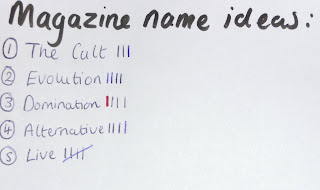All of the fonts on the cover of
MOJO are a sans serif font. This takes away the
formality of the magazine and makes it look more approachable and young. They use the colours black, grey, white and red. These are very basic colour but work together making the red and white writing stand out. They use a small drop shadow on a lot of the
cover lines making them stand out of the page but not making it look too busy. The title of the magazine is the only part that does not contain a drop shadow which is ironic as this is the part that you would think would stand out the most. To make specific features stand out they have used
red boxes behind some of the writing, this follows the colour theme but also makes them attractive to the reader.
On the front page they use some language devices. Some of these include a
rhetorical question which makes the reader want to look inside and find out about the "joke" that has been asked. They also use a
quote, this attracts the target audience as it is usually the best part of an interview making the reader want to read more of the interview.
This cover is distinctive from others as it sticks to very little change of fonts which often might not work but in this particular magazine it does. The USP (unique selling point) of MOJO could be their distinctive style of music that not many other magazines produce.
 These are some of the possible fonts that I am going to use on my front cover:
These are some of the possible fonts that I am going to use on my front cover:

























